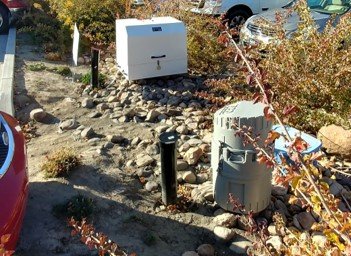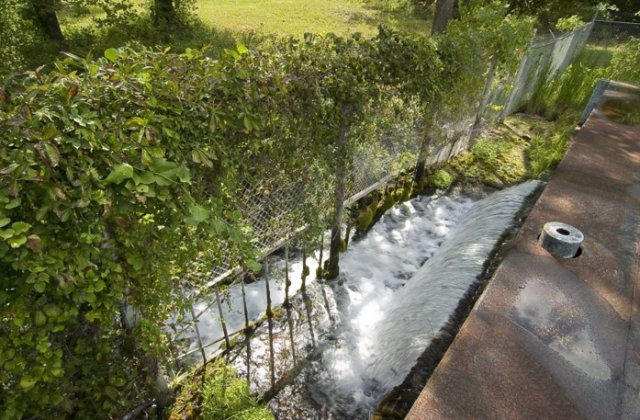Enhanced Aquifer Recharge Research
- Research to Support EPA's National Reuse Action Plan
- Arbuckle-Simpson Aquifer Research
- Contaminants and Risk Research
- National-Scale Framework for Site Selection
- Enhanced Aquifer Recharge Grant Projects
- Related Resources

Enhanced Aquifer Recharge (EAR), often interchangeably referred to as Managed Aquifer Recharge (MAR), has tremendous potential as a process to augment water supplies, replenish groundwater, and restore streamflow in the face of increasing populations, urban development, and climate change. EAR can be accomplished using surface water or treated wastewater, but in many developed areas, water managers are increasingly looking to make use of unconventional water sources including urban residential, industrial, and commercial stormwater. However, because stormwater can contain chemical and microbial contaminants that could be detrimental to receiving aquifers, posing the risk of groundwater contamination, it is therefore important to understand not only the quantity of water that can be replenished, but also the potential impacts to aquifer water quality.
Research to Support EPA's National Reuse Action Plan
In support of the goals outlined in its National Water Reuse Action Plan (WRAP), EPA researchers are investigating the application of EAR technologies and potential impacts to water quality, including the following:
- State of the science review of EAR application in the United States.
- Development of best practices for the intentional recharge of aquifers using stormwater.
- Examination of the influence of green infrastructure on groundwater quality.
- Methods to understand stormwater movement and quality in karst aquifers.
Arbuckle-Simpson Aquifer Research
The Arbuckle-Simpson Aquifer (ASA) underlies more than 500 square miles in south central Oklahoma and is the water source for almost 40,000 people. Much of EPA's research on EAR is in Ada, Oklahoma, at EPA's Robert S. Kerr Environmental Research Center, where researchers are leading efforts to develop best practices for water system recharge to aquifers and doing field work in the aquifer.
Research involves the application of hydrologic, borehole, and geophysical methods to monitor and model the physical, chemical, and biological aspects of stormwater for use in aquifer recharge. This work includes field sampling and analyses for temporal characterization of stormwater as a resource for EAR, monitoring well installations, and evaluating novel passive treatment systems for stormwater treatment during infiltration.
Byrds Mill Spring

In 2021, EPA researchers began a study in the eastern portion of the ASA near Byrds Mill Spring, the largest spring in Oklahoma and water source for most of Pontotoc County. The following studies are designed to address previous gaps in MAR research:
- Examining groundwater quality before, during, and after significant stormwater recharge events.
- Using imaging techniques to test the nature of water movement and the connection between shallow and deep groundwater in a fractured rock environment.
- Estimating the overall contribution of the enhanced recharge to groundwater supplies and quality.
This work on Byrd's Mill Spring will help EPA understand the recharge rates of surface runoff to groundwater and the movement of water and contaminants when using stormwater for recharge. These results can also be used in characterization of the risk of stormwater in EAR, and of the treatment processes that may be necessary to ensure the water is safe for the end uses.
Collaborators
This work is performed in collaboration with the Chickasaw Nation, U.S. Geological Survey, and Oklahoma State University
Contaminants and Risk Research
Source waters used for aquifer recharge often carry chemical and microbial contaminates that can be detrimental to the aquifer. Water that has gone through advanced water treatment or reverse osmosis can also cause issues in the recharged aquifer by causing contaminants already present in the aquifer to mobilize and enter the water supply; over-treated water requires conditioning to more closely match the acidity and oxygen level of the aquifer prior to use.
While soil and aquifer systems present opportunities for natural filtering and inactivation or removal of contaminants from stormwater and other sources, water withdrawn from recharged aquifers may require additional treatment to be considered safe for potable use. EPA is investigating the risks associated with EAR and methods to best mitigate these risks. Ongoing research includes the following:
- Using a variety of testing methods to understand chemical risks, particularly for potable end uses.
- Evaluating tools that can be used to characterize the aquifer geology and hydrology, collection and movement of contaminants, and monitoring needs for EAR systems.
- Determining geochemical impacts within recharged aquifers and reducing uncertainty in microbial and chemical contaminant levels.
National-Scale Framework for Site Selection
A comprehensive framework is being developed, outlined below, that will provide a holistic evaluation of suitable locations for EAR across the country.
- Identification of the drivers, such as water scarcity, seawater intrusion, flood management, agricultural use, and cost, of fit-for-purpose EAR implementation.
- Assessment of hydrogeological characteristics of the aquifer, such as storage potential, transmissivity, soil, infiltration characteristics, recoverability, and water quality.
- Evaluation of the availability of water for infiltration and recharge, specifically, surface water surpluses, reclaimed water, effluent discharge, and groundwater.
- Estimation of current and future water demands under current and future climate conditions.
Initial efforts will focus on two place-based case study locations and two types of EAR sites, water banking and seawater intrusion. By 2027, the goal is to develop a more generalizable framework to aid decision making on suitable locations for EAR across the country.
EAR Grant Projects
Enhanced Aquifer Recharge Performance and Potential Risk in Different Regional and Hydrogeological Settings
The EPA issued a Request for Applications (RFA) for a Science to Achieve Results (STAR) grant for research to better understand fit-for-purpose and locally appropriate uses and risks of EAR using different source waters, with different end goals in diverse land use and hydrogeologic settings. Award recipients are anticipated to be announced early August 2023. RFA Announcement
Life-Cycle Analysis to Support Cost-Effective Enhanced Aquifer Recharge Request for Applications
In 2022, the University of California was awarded a Science to Achieve Results (STAR) grant to develop an EAR Lifecycle Map to serve as a guide for resource managers, stormwater professionals, and local decisionmakers when planning EAR implementation. This research will develop and formalize best practices for EAR based on geochemical and physical considerations, legal and institutional considerations, and cost-benefit analysis and life-cycle assessment. Through applied research, decision-support tools, and public engagement, the grantee's resulting report may help lower current barriers to widespread EAR application and bring awareness to its co-benefits.
A Knowledge-to-Implementation Framework for Enhanced Aquifer Recharge
State and Tribal Assistance Grants (STAG)
The Infrastructure Investment and Jobs Act authorized to be appropriated up to $5million for each of fiscal years 2022-2026 for a new EPA State and Tribal Assistance Grants (STAG) program. These grants will allow states, tribes, and local government to carry out groundwater research on enhanced aquifer use and recharge in support of sole source aquifers. EPA is working to determine the method of implementation for this program, and additional information is forthcoming.
Related Resources
Models and Tools
Publications
- Occurrence and prevalence of antimicrobial resistance in urban karst groundwater systems based on targeted resistome analysis (2023)
- Electrical Resistivity Imaging of an Enhanced Aquifer Recharge Site (2022)
- Protecting Groundwater Resources within the Arbuckle-Simpson Aquifer in Oklahoma (2021 Science Matters article)
- Enhanced Aquifer Recharge of Stormwater in the United States: State of the Science Review (2021 Report)
- The Influence of Stormwater Management Practices and Wastewater Infiltration on Groundwater Quality: Case Studies (2020 Report)
- EPA Research Publications about Enhanced Aquifer Recharge
- EPA Publications about Microbial Risk Assessment
- EPA Publications about Water Reuse
Webinar Recording
- Water Research Webinar: An Introduction to EPA's Enhanced Aquifer Recharge Research (November 29, 2023)
- Water Research Webinar: Enhanced Aquifer Recharge: Influence of Stormwater on Groundwater Quality and Aquifer Recharge (April 28, 2021)
